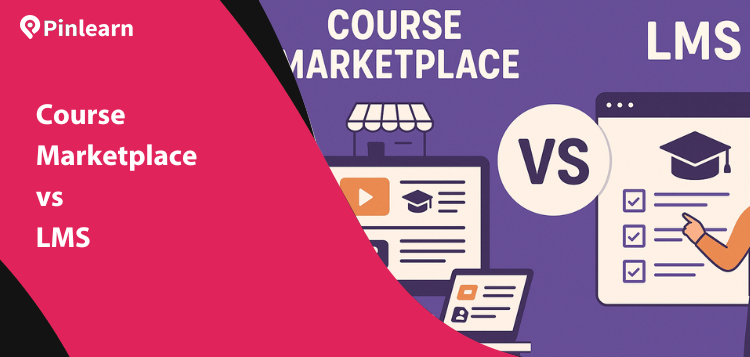Course Marketplace vs LMS: What’s the Difference?
Whether you’re an individual course creator, educational institution or large organisation, choosing the right platform for hosting your course is paramount. It decides your course impact, potential reach, and ultimately, overall revenue.
Two major avenues for course creators are: course marketplaces and LMS. Course marketplaces offer visibility and existing infrastructure for course creators. On the other hand, LMS provides more control over branding and the delivery of the course.
Understanding the educational needs of your learners makes it easier to choose the right platform. This blog draws a detailed course marketplace vs LMS comparison so you make the right decision based on your business goals and vision.
So, let’s get started!
What is Course Marketplace?
A course marketplace is a platform where multiple creators come together to create and sell courses. It has a broader reach and a diverse learner community. It’s an e-commerce site for online courses; learners can browse courses from multiple creators and purchase ones they prefer.
Popular course marketplaces like Udemy, Coursera, and EdX have established their authority in this industry. While they handle the technical aspects like hosting and payment processing, creators can focus on creating and selling their courses. Consider it as Amazon, where you can find all kinds of courses from Python to Photoshop.
Pros
- Connects a wide variety of audiences to multiple instructors
- Access to a huge & diverse audience base
- An extensive course library that operates on a revenue-sharing model
- Due to the built-in audience, creators need to invest less in marketing efforts
- Easy course creation and management for course creators
- No additional costs for hosting and operating an independent
Cons
- Limited control over branding, business model, and pricing
- Fierce competition as multiple creators publish on the marketplace
- High commissions cut over creator earnings
- Limited or no communication with students
- Less ownership or control over your business
💡Choose the best marketplace: Explore the best online learning site like Udemy to find the best platform of your needs.
What is LMS?
A Learning Management System (LMS) is software designed to manage and track learning programs within an organization or institution. It hosts a variety of content, including videos, courses, workshops, and documents. LMS is typically feature-rich and robust to host organizational content. Instructors upload course materials, assignments, and quizzes and track learners’ progress.
Customized learning paths, extensive analytics, and user management are the key features of LMS. Organizations like schools, universities, and large companies use LMS to deliver training programs. Moodle, Canvas, and BrainCert are a few commonly used LMSs.
Unlike the marketplace, LMS caters to the learning needs of internal audiences, such as employees and students. The LMS data often includes critical organizational data. Hence, LMSs are created with a strong focus on data protection and compliance. Most LMSs include advanced functionalities for user management and reporting.
Pros
- Centralized content management and administration
- Customized learning paths based on learners’ needs
- Easy integration with enterprise management systems
- Efficient content management to structure large amounts of information
- Extensive reporting and analytics on course completion, learner progress, and performance data
- Robust security features like SSO, SSL certificates, user roles, etc.
- Scalable to accommodate a large audience base and courses
- Seamlessly integrate with different learning tools and enterprise systems
Cons
- Need extensive training and technical support to completely understand the intricacies of LMS
- No built-in support for marketing and selling courses; focus on internal training
- LMS platforms have a higher cost depending on the feature set and customization
- Challenges to deliver personalized learning paths
- Technical complexities to integrate with existing organizational systems
💡 Choose the best LMS: Check out our guide on the best LMS for small businesses.
Course Marketplace vs. LMS: Comparative Analysis
If you’re a course creator, making a choice between a course marketplace and an LMS is essential. Here’s a quick course marketplace vs LMS comparison to decide what’s right for your learning business.
1. Purpose and Scope
Let’s start with the basic purpose and scope of the course marketplace and LMS.
Course Marketplace
The core purpose of the course marketplace is to bridge the gap between learners and experts offering courses. While learners get access to a broad range of courses, creators can create and sell their courses and earn a sizable revenue.
Marketplace offers visibility and technical infrastructure to creators for selling courses. The scope of the marketplace extends beyond market reach and creator empowerment. Typically, marketplaces monetize from commission-based, subscription, or freemium models. Creators can monetize from multiple revenue streams and maximize their earnings.
LMS
The main goal of LMS is to curate, deliver, and track the training content. The centralized content management reduces overhead costs and improves the learning outcomes.
Designed for managing comprehensive learning programs across institutions and companies.
The scope of LMS extends across different scenarios:
- Onboarding – HR can use LMS to offer a seamless onboarding experience from day one. LMS personalizes and automates onboarding tasks and developmental goals based on learners.
- Employee training – From sales training to soft skill training, LMS facilitate accessing content, tracking progress, and role-playing scenarios.
- Upskilling and reskilling – With evolving trends like AI and machine learning, organizations value competence more than ever. LMS solutions are a cost-effective way to upskill and reskill the organisational workforce.
- Compliance & certification training – To ensure the safety and compliance of employees, businesses can use an LMS. Cybersecurity training, workplace safety, and industry-specific regulations are some common areas.
2. Content Creation and Management
Course Marketplace
The next point of difference is content or course creation. Course marketplaces are easy, intuitive platforms designed for easy and quick publishing. For example, they offer drag-and-drop course builders to seamlessly create and sell courses.
Ready-made templates, easy hosting, and interactive features make it perfect for non-technical users. Video lessons, text lectures, quizzes, and downloadable resources are the common content formats on course marketplaces. On the flipside, there’s limited control over look and feel and ownership of the course.
LMS
LMS offers advanced course creation & management capabilities. It’s typically suitable for creating courses in large volumes in organizations & educational institutions. Users can easily create customized learning environments.
Instructors have the freedom to control the course structure, branding, and even learning experience. Slides, microlearning content, training videos, sales enablement content, gamified modules, etc., are common types of LMS content.
LMS also supports advanced content like SCORM, xAPI, certificates, etc. It’s suitable for both individual creators and large organizations. Instructors own their content on LMS and can market, upsell or resell the content.
3. Feature Set
Course Marketplace
Marketplaces are typically used to connect learners with instructors. So, the feature-set focuses on course hosting & delivery, basic analytics and communication with learners. It has limited capabilities for reporting and user management.
The features are for both learners and instructors. Udemy-like platforms emphasise key features like course creation, discoverability, search and filtering, payment processing, etc. For learners, the features range from personalized learning paths to access to diverse content.
LMS
LMSs are designed to create, track, and deliver training programs. So, LMSs don’t just focus on content creation, but offer powerful analytics and reporting. From user management to compliance tracking, the focus extends beyond mere course management.
Each LMS is unique and customized to suit the business needs of the organization. Most LMSs offer learner-centric learning with advanced features like quizzes, progress reports, certificates, etc. Deeper learner engagement features include gamification, live classes, forums, etc.
4. User Experience
Course Marketplace
A good, intuitive UX makes it easier for instructors to create, publish, and deliver courses. It offers tools for publishing videos, text, quizzes, etc. Features like intuitive search, personalized recommendations, simple enrollments and community support provide a positive UX experience.
The minimal course creation & delivery makes it the preferred choice for new creators. While marketplaces reduce friction between users and the platform, there’s limited control over features, pricing, or platform policies.
LMS
In contrast, LMSs are feature-rich and have a steeper learning curve. Whether it’s server management, software updates, or security, instructors and businesses need training to set up the LMS.
Given the complexity of features and functionalities, learners take time to get acquainted with the new LMS. The complexity can even reduce user engagement. But modern LMS flatten the learning curve for both instructors and learners. Features like gamification, collaborative learning, audio and video learning make learning interactive.
6. Target Audience and Scalability
Course Marketplace
Both the course marketplace and LMS cater to different audiences. Course marketplaces like Udemy, Coursera, and EdX are a lucrative platform for individual course creators or instructors and small businesses.
The user-friendly interface, minimal setup and built-in audience reduce the cost and efforts for selling standalone courses. Also, the built-in audience reduces the marketing efforts for new course creators.
LMS
LMSs are designed for educational institutions, corporate training programs, and large-scale businesses. So, they can accommodate thousands of learners and multiple courses simultaneously.
Unlike a course marketplace, an LMS can scale along with your educational business. Scalability is one of the most important aspects for choosing your LMS. Your chosen LMS must be able to cater to increasing learners and courses.
7. User Management
Course marketplace
In course marketplaces, the platform owner has more control than course creators. They are basically designed for easy onboarding, better visibility, and minimal cost. So, the b
Two basic user roles you can find are: “student” and “instructor”. Instructors have limited access to user data, such as course progress, ratings, and engagement statistics. They cannot bulk-enrol or assign courses to learners.
LMS
On the other hand, the user management is advanced in LMS. The primary reason for advanced user management is the confidential and sensitive data hosted by LMS systems. So, it’s crucial to level up the security.
For example, Moodle offers roles like “Student”, “Teacher”, “non-editing teacher”, and “course manager. “ SCORM-compliant corporate LMS allows department managers to review the course. Besides, manual, bulk uploads or auto-enrollments are possible in LMS.
Unlike the course marketplace, instructors have complete access to learner progress and course analytics. LMS typically tailors customized learning paths with pre-assessment, data-driven insights, adaptive learning techniques, etc.
8. Control and Ownership
Course marketplace
One of the downsides of a course marketplace is limited ownership and control over branding. Course creators are bound to the policies of the marketplace. This means they need to conform to the design and templates of the platform. It limits the instructor’s freedom to build a brand and content style.
LMS
Unparalleled control over brand design and ownership makes LMS a preferred choice for businesses. From branding to customized learning paths, LMS offers more control over branding.
Instructors can choose different teaching strategies, interactive elements, or multimedia integration. This makes your content tailored to different learning styles, demographics, needs, etc.
LMS offers control over branding with white-labelling and customization. Thus, organizations can customize logos, layout, and color schemes to align with brand guidelines.
9. Cost and Investment
Course Marketplace
Creating and selling a course on the marketplace is easy and doesn’t involve any upfront cost. Marketplaces like Udemy and Coursera don’t charge a fee for hosting your courses. Instead, they charge a portion of your course revenue (Udemy commissions range from 3%-63%).
So, the only cost involved for creators is the one-time course creation (research, video, design, etc). From an ROI perspective, it’s a low investment but significant revenue return for instructors.
LMS
For educational institutions or corporate organizations, the initial setup cost is high. Launching a customizable, secure, and scalable business is the main reason for choosing an LMS.
Businesses need to deliver consistent training to students or employees. This calls for customized learning paths, progress tracking, advanced integrations and compliance requirements.
The overall cost for LMS includes the upfront subscription or licensing cost + ongoing maintenance and support cost. Now, this again varies depending on whether you choose a self-hosted or cloud-hosted LMS. Additionally, the customization & integrations like branding, SSO, HR/CRM could increase the cost further.
Speaking about the ROI, LMS is a great long-term investment for large-scale businesses. The overall cost is justified by productivity, reduced overhead training costs, and compliance training.
Choosing the Right Platform for Your Learning Business
Still struggling to choose the right platform for your learning business?
Let’s summarize the essential points to make it easier for you!
Choose a course marketplace if:
- You’re an individual instructor and need easy course creation and management
- Limited budget and don’t have an upfront investment
- Need to reach a wide and diverse audience
- Not adept with the technical aspects of hosting & delivering courses, and the prime focus is on content creation.
- Need help with marketing and promoting your course
- You need to sell your courses and offer instant access to learners
Choose an LMS if:
- You’re an educational institution, corporate, or government agency with a large number of students/ employees
- You need to constantly deliver training, track progress, and ensure compliance
- You want to build a platform with complete control over your brand identity and messaging
- You’re looking for a customizable, secure, and scalable educational platform
- You expect a high revenue potential from your business
- You’re business is expected to scale with the number of users and courses over time
- You have adequate expertise & budget with hosting, branding, and operating an individual platform
FAQ-Related to Course Marketplace vs LMS
1. What’s the key difference between the course marketplace and LMS?
Course marketplace and LMS differ in several aspects, including purpose, control, ownership, feature set, course creation, and cost.
Here’s how both fare in these aspects:
- Purpose – The primary difference is that a course marketplace caters to individual instructors creating and selling courses. On the other hand, LMS manages and delivers content to large organizations.
- Control and ownership – Branding and ownership are limited in the course marketplace; creators are subjected to platform policies. Instructors have complete ownership over their courses in LMS.
- Feature set – The features of the course marketplace focus on course creation, discoverability, and payment. LMSs are feature-rich and extend beyond course creation & delivery. This includes reporting, analytics, and compliance tracking.
- Cost – Course marketplaces offer low-cost course creation, while LMS involves a high initial setup cost.
2. What are the disadvantages of using LMS?
The high initial setup cost, technical complexities, and steep learning curve are the downsides of LMS.
3. Which is the best platform for selling courses?
Popular course marketplaces include Udemy, Coursera, EdX, and SaaS platforms like Kajabi. Thinkific is best for selling online courses.





